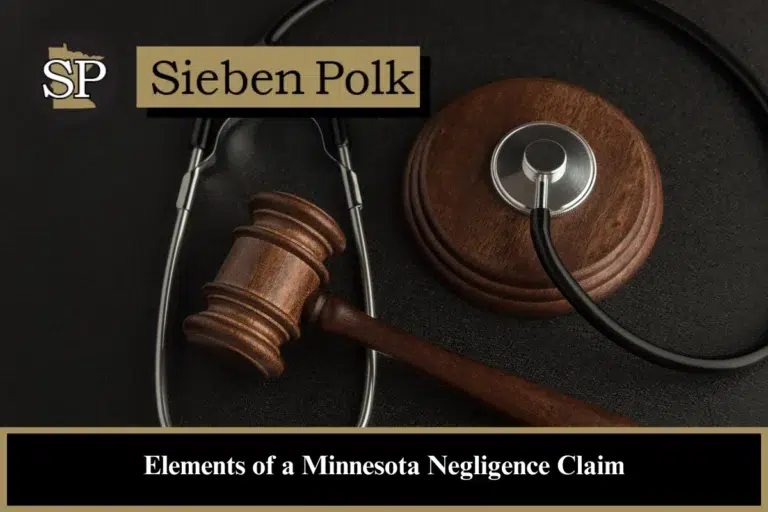A settlement demand letter is a document you send to an opposing party explaining how you were injured, why the opposing party is liable for your damages, and how much compensation you seek. An effective demand letter can help jumpstart negotiations to settle your dispute outside of court without a hearing or a trial. Our Eagan personal injury attorneys at Sieben Polk P.A. can help you through the settlement process in Minnesota and craft a strong demand letter.
When most people think about personal injuries, they think about lawsuits. However, accident victims can sometimes get the compensation they need without going to court by agreeing to a settlement. Often, settlement negotiations begin with a settlement demand letter sent on behalf of the injured victim. Often, a settlement is reached because the injured victim sent a settlement demand letter. But, to get the most out of your demand letter, it must accurately explain what happened, the damages you suffered, and why the recipient is liable.
If someone else’s negligence has injured you, the experienced Minnesota personal injury lawyers at Sieben Polk P.A. can help you navigate the legal process and craft an effective demand letter.
- What Is a Settlement Demand Letter?
- Why Is a Settlement Demand Letter Important?
- Do I Need To Hire an Attorney To Write a Settlement Demand Letter?
- What Should I Include in My Settlement Demand Letter?
- How Do I Write a Settlement Demand Letter?
- How To Deliver a Settlement Demand Letter
- Next Steps After Sending a Settlement Demand Letter
- Our Personal Injury Attorneys Are Here To Help
What Is a Settlement Demand Letter?
A settlement demand letter is a formal request for compensation sent to the party responsible for an injury or their insurance company.
Demand letters are used in all types of personal injury claims, including car accidents, motorcycle accidents, truck accidents, and wrongful death actions.
The letter should contain the following information:
- How your injury happened
- The types of injuries you suffered
- The expenses and losses your injury caused
- The legal basis for holding the recipient responsible
- The terms and conditions that you would accept without going to court
Usually, the demand letter starts negotiations so that the parties can reach a mutually acceptable resolution.
Why Is a Settlement Demand Letter Important?
Settlement demand letters can help injured victims get the compensation they need faster than a lawsuit. Even if the letter’s recipient doesn’t agree to the proposed terms, the letter starts the negotiation process. If that negotiation facilitates a fast out-of-court resolution, then both parties have likely saved time and money.
Do I Need To Hire an Attorney To Write a Settlement Demand Letter?
Having an attorney write the settlement demand letter for you isn’t mandatory. However, working with an attorney with a track record of successfully settling claims like yours is critical.
Depending on the circumstances, you may benefit from working with an experienced lawyer who can calculate a fair settlement amount, explain how the relevant laws apply to your case, gather evidence, and help you write the most effective letter possible.
What Should I Include in My Settlement Demand Letter?
Before sending a demand letter, you should wait until you reach your maximum medical improvement, or MMI. MMI is when a patient’s medical condition has improved to the fullest extent possible, and further medical treatment is not expected to result in significant improvement.
Once your condition is stable, it’s time to send the settlement demand letter.
A settlement demand letter typically includes the following:
- A description of the incident that caused your injuries
- The legal basis for holding the recipient responsible for your damages
- A summary of your economic damages, which are the quantifiable costs stemming from your injury, such as medical expenses and lost wages
- A summary of non-economic damages—the harder-to–quantify impacts on your life, such as pain and suffering
- A compensation demand that accounts for all of your damages
How Do I Write a Settlement Demand Letter?
The content and quality of your letter can influence the settlement you receive, so you want to start from as strong a position as possible by accurately recounting the facts and asking for the proper amount of compensation. Although frustration with the situation is understandable, maintaining a respectful and professional tone will usually help you get a better response and outcome.
Things To Remember When Writing a Settlement Demand Letter
Consider these tips when writing a demand letter:
- Be professional and respectful: Avoid using offensive or inflammatory language, which can escalate the dispute and hinder productive negotiations. Focus on presenting your case and proposed resolution constructively.
- Clarity and conciseness: Clearly state the issues and your proposed resolution without unnecessary complexity or ambiguity.
- Provide background information: Give a brief overview of the dispute’s background, including key facts, dates, and relevant events. This helps the recipient understand the context of your claim.
- State your legal position: Clearly explain your legal position and the basis for your claims. Reference the relevant laws, contracts, or legal principles supporting your position.
- Specify the claims and damages: Identify the specific claims or issues you want to address and provide a detailed breakdown of financial losses and other harm suffered.
- Settlement proposal: Clearly outline your settlement proposal, including the terms, conditions, and dollar amount you’re willing to accept to resolve the dispute. Be specific when explaining the remedies you seek, whether a monetary settlement for injuries or property damage, specific actions to be taken, or other terms.
- Deadline for response: Include a reasonable deadline by which you expect the recipient to respond or indicate their willingness to negotiate. Setting a deadline creates a sense of urgency and helps move the process forward.
- Provide evidence: If you have relevant documents, evidence, or medical records that support your claims, consider attaching copies of them to the letter. This can strengthen your position and help the other side better understand your damages.
- Proofread and edit: Carefully proofread the letter for grammar, spelling, and typographical errors. A well-written and error-free letter demonstrates professionalism.
- Keep copies and records: Maintain copies of the demand letter and any responses received. Keeping a record of all communication can help you during future legal proceedings.
- Consult with an attorney: If you’re unsure about the legal aspects of your dispute or the content of your letter, consider consulting with an attorney specializing in personal injury law or other relevant area of law. They can provide guidance and help you write a stronger letter.
Remember, an effective settlement demand letter can set the tone for productive negotiations and increase the likelihood of reaching a positive resolution. It’s an important document, so take time to prepare it carefully and thoughtfully.
Example of a Settlement Demand Letter
The following is an example of a template settlement demand letter that you can use. Simply customize any text in brackets to reflect the facts of your situation.
Re: Settlement Demand for [Brief Description of the Dispute]
Dear [Recipient’s Name],
I am writing to formally request the resolution of the above-referenced dispute through an amicable settlement. This letter outlines the background of the dispute, my legal position, the claims and damages involved, and my proposed terms for settlement.
Background:
[Provide a brief overview of the dispute, including relevant dates and events.]
Legal Position:
[Explain your legal position, referencing applicable laws, contracts, or legal principles supporting your claims.]
Claims and Damages:
[Specify the specific claims or issues you want to address and quantify the damages or remedies you seek. Provide a detailed breakdown of financial losses or other harm suffered.]
Settlement Proposal:
[Clearly outline your settlement proposal, including the terms and conditions you will accept to resolve the dispute. Be specific about the remedies you seek, whether a monetary settlement, actions to be taken, or other terms.]
[Include any relevant deadlines for payment or other actions.]
[If applicable, mention any supporting documents or evidence attached to the letter.]
Deadline for Response:
I kindly request that you respond to this letter within [reasonable timeframe, e.g., 14 days] from the date of receipt. A deadline will allow us to expedite the resolution process and avoid unnecessary delays.
Avoidance of Litigation:
I believe an amicable settlement is in all parties’ best interest. Litigation can be time-consuming and costly, and I hope we can resolve this matter without resorting to legal proceedings.
I am open to negotiations and discussions to reach a fair and equitable resolution to this dispute. Finding common ground will benefit both parties and allow us to put this matter behind us.
Please direct your response to the address or email provided above. If you have any questions or require further information, do not hesitate to contact me.
I look forward to your prompt response and a constructive dialogue to reach a resolution.
Sincerely,
[Your Full Name]
[Your Signature (if sending a hard copy)]
[Enclosures: List any attached supporting documents or evidence.]
How To Deliver a Settlement Demand Letter
You should always send a settlement demand letter via certified mail. Send the letter with a signature requirement and get delivery confirmation. Those will serve as proof the intended recipient received the letter.
Next Steps After Sending a Settlement Demand Letter
After sending your settlement demand letter, several outcomes are possible.
Ideally, the opposing party agrees to all your proposed settlement terms, resolving your dispute without further legal action.
Sometimes, the other party may reject your initial settlement proposal but be willing to negotiate. They may counter with a settlement offer, initiating a back-and-forth negotiation process that will hopefully end with a settlement that fairly compensates you for your damages.
If the opposing party rejects your settlement demand and refuses to negotiate, you may decide to file a lawsuit. In that case, you should consult with an attorney to understand what the legal process will entail, how long the process may take, and how much your claim may be worth.
How Long Will It Take To Settle My Personal Injury Case?
The timeline for settling a personal injury case can vary significantly based on several factors, including the following:
- Severity of injuries: Cases involving more severe injuries or long-term consequences may take longer to settle, as the full extent of damages may not be immediately apparent.
- Liability disputes: Cases in which liability is contested can be more time-consuming because they often require additional investigation and evidence gathering.
- Negotiation efforts: The speed of settlement negotiations depends on both parties’ willingness to engage in a productive dialogue and reach an agreement.
- Court dockets: If your case proceeds to trial, the availability of court dates and the court’s caseload can affect how long it takes for your case to be heard.
- Complexity: Complex cases with multiple parties or intricate legal issues may require more time for coordination, preparation, and presentation.
It’s important to discuss the expected timeline with your attorney, if you have one, as they can provide a more accurate estimate based on the specific details of your case.
Our Personal Injury Attorneys Are Here To Help
If you or a loved one has received undue pain and suffering due to an accident or needs assistance with writing a settlement demand letter, contact our experienced Eagan, Minnesota, personal injury lawyers. Call Sieben Polk P.A. at 651-437-3148 for a free consultation.




